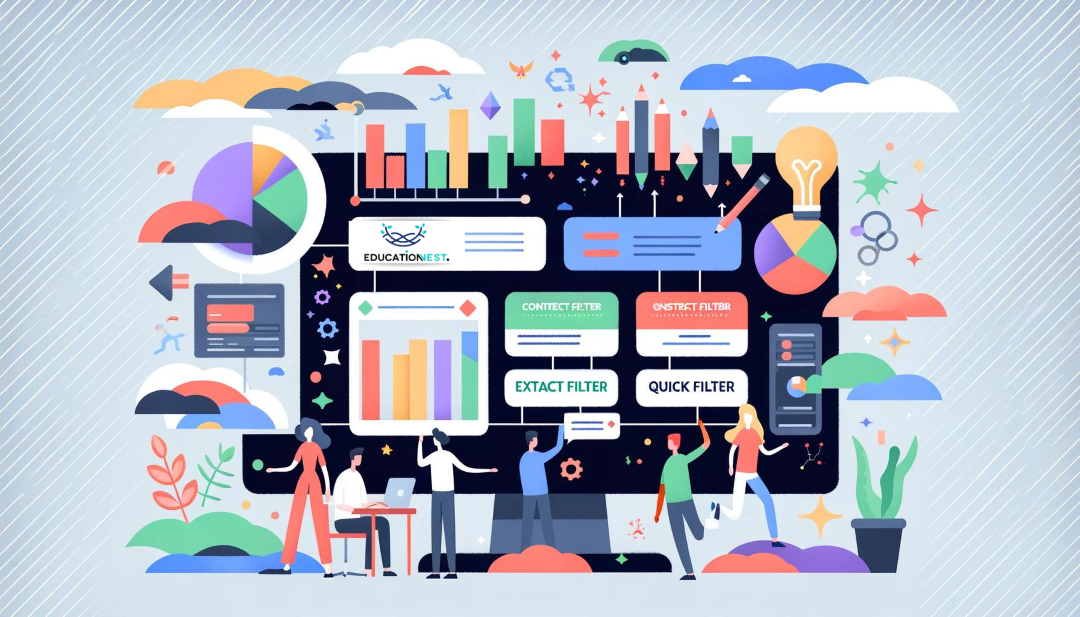
In the world of data visualization, Tableau stands out for its ability to turn complex data sets into insightful and interactive dashboards. Among its many features, filters in Tableau play a crucial role in refining and narrowing down data, which helps in uncovering hidden insights. Whether you’re a business analyst, a data scientist, or someone just curious about data, understanding the different types of filters in Tableau can significantly enhance your data exploration capabilities. From the context filter in Tableau, which acts as a master filter, to the extract filter in Tableau, designed for handling large data sets efficiently, and the quick filter in Tableau, offering on-the-fly data filtering, each type serves a unique purpose. Additionally, when working with filters in Tableau dashboard, knowing how to apply and manage these filters can make your dashboards more dynamic and user-friendly. So, let’s dive into the world of Tableau filters and see how they can transform your data visualization journey.
Filters in Tableau: Meaning
Imagine you’ve got a big, colorful box of LEGOs, but you’re on a mission to build a spaceship. Now, not every LEGO piece in that box is going to help you make your spaceship, right? You need specific shapes, sizes, and colors. So, what do you do? You start sorting through your LEGOs to find just the pieces you need. That’s exactly what filters in Tableau do with your data.
Think of your data as the LEGO pieces. Some of it is useful for the question you’re trying to answer (like the spaceship parts), and some of it isn’t. Filters help you pick out the bits of data that matter most for what you’re looking at. Whether you’re trying to see sales in a particular region, focus on data from the last year, or only look at products of a certain type, filters are your go-to tool for removing the clutter. This way, you get to focus on the data that makes sense for your project, making your analysis clearer and your decisions smarter. Just like sorting your LEGOs makes building that spaceship a whole lot easier!
Types of Filters in Tableau

Imagine you’ve got a giant jar of mixed candies, but you’re only interested in certain flavors or colors. In Tableau, filters are like your hands that pick out just the candies you want, leaving the rest in the jar.
Context Filter: This is like first deciding you only want the green candies. By picking these out, you’re setting the stage for more specific choices later. It’s like saying, “Okay, from now on, I’m only dealing with the green ones.”
Extract Filter: Imagine you’ve got a rule that out of all the candies you picked, you only want those made in a certain year. An extract filter helps you take out just those candies, so you’re left with a smaller, more manageable bunch to choose from.
Quick Filter: Now, from your selected candies, you decide you want to try different flavors one by one. A quick filter is like having a dial that lets you switch between flavors easily without digging through the pile each time.
In essence, each type of filter in Tableau helps you narrow down your data—like sorting candies—so you end up with exactly what you need for your analysis or story, making your work both easier and more precise.
Context Filter in Tableau
Let’s simplify “context filter in Tableau” to make it super clear. Imagine you’re planning a movie night but only want to watch comedies that are also romantic. In Tableau, a context filter helps you narrow down your choices just like picking a genre first, say comedies, before getting even more specific.
Here’s how it works: when you set a context filter, you’re telling Tableau to pay attention only to certain data. It’s like saying, “Hey, Tableau, let’s only look at comedies for now.” Once you’ve set this context, any other filters you apply will only sort through the comedies, not the entire movie collection. This makes everything faster and more focused because Tableau isn’t overwhelmed by too much information.
So, if you then decide you only want comedies from the 2000s, Tableau will only look at the comedies to find those from the 2000s. It won’t waste time sifting through action or horror movies because your context filter has already put them aside.
In short, a context filter in Tableau is like picking your main dish at a buffet. Once you’ve chosen, you then decide on the sides but within the context of your main dish choice. This makes your analysis cleaner, quicker, and much more to the point.
Extract Filter in Tableau
Let’s break down “extract filter in Tableau”. Imagine you’re collecting seashells on a vast beach, but you only want to bring home the ones that are pink. An extract filter in Tableau is like deciding to only fill your bucket with pink seashells, ignoring all the rest right from the start.
Here’s how it plays out: When you use an extract filter, you’re telling Tableau, “From all the data we have, I only care about this specific part.” It’s like saying, “I’m only interested in pink seashells.” You grab those pink shells and put them in your bucket (or in this case, a data extract). Now, whenever you work with your data, you’re only dealing with the pink seashells you’ve selected. Everything else is out of the picture.
This approach is super helpful when you’re dealing with a ton of data but only need a portion of it for your analysis. By using an extract filter, you make your dataset smaller and more manageable, which can help your Tableau dashboards run faster and smoother.
In essence, an extract filter helps you keep only the data you really need, similar to choosing only pink seashells from a beach full of different colors. It’s about focusing on what matters most for your specific analysis or project.
Also Read:
Tableau Tutorial: What is Tableau Used For
Quick Filter in Tableau
Let’s make “quick filter in Tableau” as easy to understand as choosing what to watch on TV. Imagine you have a remote control that can instantly change channels based on what you feel like watching: movies, sports, or cartoons. A quick filter in Tableau is like that remote control but for your data.
When you use a quick filter, you’re telling Tableau, “Show me exactly what I want to see right now.” If your data is a mix of sales from different years, and you’re only interested in seeing what happened in 2020, a quick filter lets you click and immediately view just the 2020 sales. It’s like choosing to watch sports and instantly getting all the sports channels lined up.
The beauty of a quick filter is its flexibility. You can switch views, from one type of data to another, as easily as flipping channels. This makes exploring your data not only faster but also more intuitive. You can dive deep into specific parts of your data without getting lost in the weeds.
In short, a quick filter in Tableau gives you the power to focus on what’s important at the moment, making it easier to find insights and make decisions quickly. It’s like having a magic remote control for your data, bringing the information you need right to your fingertips.
Conclusion
In summary, Tableau’s filtering capabilities are essential for anyone looking to refine their data analysis process. By understanding and applying different types of filters, you can ensure that your dashboards are not only visually appealing but also incredibly functional and tailored to meet the specific needs of your audience.
Filters in Tableau transform raw data into insightful, interactive visualizations tailored to your audience’s needs. By mastering context, extract, and quick filters, you empower yourself and your audience to dive deep into the data, uncovering valuable insights that drive informed decisions. Happy filtering!

